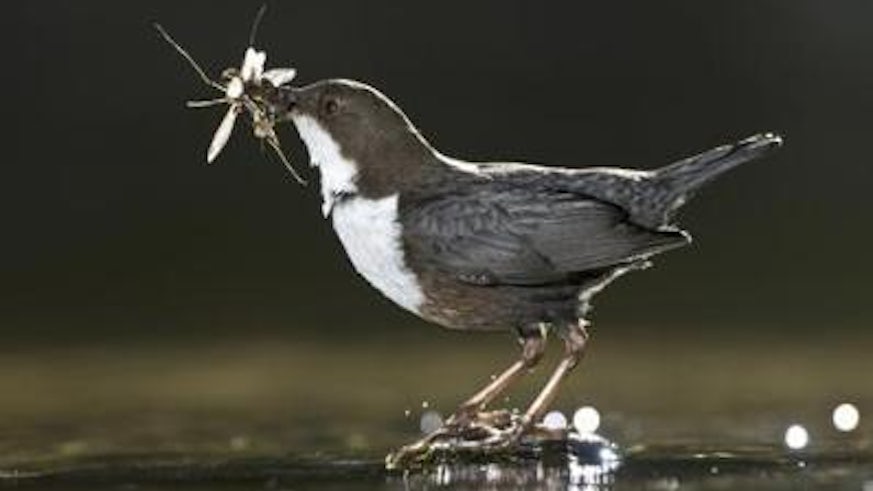Thyroid disruption in river birds
29 April 2014

New research indicates that hormone disrupting pollutants are affecting the health and development of wild birds nesting along the urban rivers of South Wales.
Findings published today in the Environmental Toxicology and Chemistry journal reveal that chicks of the Eurasian Dipper – a river bird that feeds exclusively on insects and fish in upland streams – are underweight compared to their rural counterparts. Also of concern is that birds nesting in urban rivers have altered hormone levels, and are hatching fewer female chicks than those nesting along rural rivers, which could have negative implications for the population's breeding and survival.
Data obtained by a team of scientists from Cardiff, working in collaboration with the Universities of Saskatchewan and Exeter, and the Natural Environment Research Council, suggest that urban contaminants such as PCBs (polychlorinated biphenyls) and PBDE flame-retardant chemicals (polybrominated diphenyl ethers) acquired through their food are to blame. Results showed a strong correlation between contamination by PBDEs and PCBs with depressed thyroid hormone levels in chicks – one thyroid hormone was 43% lower in chicks from urban rivers than those rural rivers.
Professor Steve Ormerod from the School of Biosciences, who has spent 35 years investigating rivers, commented:
"Our findings are important in showing that pollutants are still a source of concern for the wildlife along Britain's urban rivers despite very major recovery from the gross pollution problems of the past. Wild birds, such as dippers, are very important indicators of environmental well-being and food-web contamination, and we need to know if populations, other species – or even people - are also at risk."
Dr Christy Morrissey from the School of Environment and Sustainability at the University of Saskatchewan said:
"We've known for some time that endocrine disrupting substances – the so-called 'gender-bending' chemicals from sewage and other waste water – can affect normal sex development in fish. These are some of the first data to show that PCBs and PBDEs might be causing thyroid disruption in wild birds and interfering with normal animal development."
Along the formerly heavily polluted rivers of South Wales, the same team showed previously how urban Dippers are exposed to a complex mix of chemical contaminants and dominantly, PCBs and PBDEs. Given the sensitivity of the endocrine system –responsible for controlling thyroid and other hormones – researchers have recognised that alterations in thyroid hormone levels are an important predictor in pollution-induced developmental effects in animals.
The effects of thyroid hormone disruptors on birds are diverse but frequently include impaired growth; cognitive dysfunction; compromised immune function changes in motor activity; and behavioural abnormalities that can persist into adulthood.
As top predators, Dippers are valuable monitors of river pollution that can help assess whether urban contaminants are influencing wildlife reproduction and development. Given the latest findings, scientists are now planning to examine whether effects on dipper sex ratios and thyroid hormones have consequences on individual survival and fitness which could alter wider population dynamics. They also plan to locate the exact sources of the pollution.
Commenting on the research findings, the RSPB's Futurescape Officer John Clark said:
"The return of Dippers to urban rivers is a fantastic outcome of pollution reduction in the UK. However, this study highlights the importance of birds as an indicator that some pollutants still persist in our rivers at harmful levels. We need to work in partnership with water companies, regulators, statutory agencies and communities at a catchment scale to address those practices that continue to introduce damaging chemicals to our rivers. The RSPB's Futurescapes conservation work programme is doing exactly that – tackling environmental challenges at a truly large, landscape-scale, level."
The abstract and full paper can be accessed online.